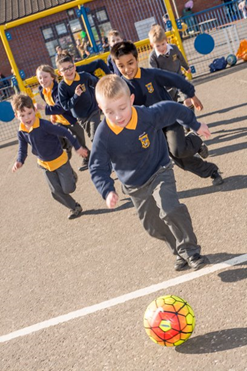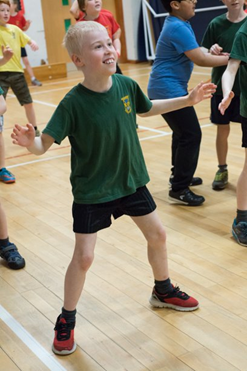Use 'Print preview' to check the number of pages and printer settings.
Print functionality varies between browsers.
Printable page generated Tuesday, 25 November 2025, 4:46 PM
2 Whole school approaches to inclusion
Section overview
In this section you will explore whole school approaches to support inclusion. You will explore the following areas:
2.1 Inclusive approaches overview
2.2 Ensuring schools and classrooms are inclusive
2.3 Supporting whole school approaches to inclusion.
2.1 Inclusive approaches overview
Whole school approaches help to form an inclusive ethos. When these form part of everyday practice, they support the inclusion, engagement and participation of all learners. In an inclusive school, all learners are made to feel welcome and included, and individual differences are respected, normalised and valued.
Planning and developing an inclusive child centred approach to learning and teaching can support a range of additional support needs. An inclusive learning environment will support all learners to access the curriculum and participate in a range of experiences provided through a flexible, accessible and inclusive curriculum.
A combination of factors supports the development of an inclusive school community and learning environment.
2.2 Ensuring schools and classrooms are inclusive
It is everyone’s job to be inclusive in their approach and to support all learners.
The standards for initial teacher education and registration, career-long professional learning and leadership are all underpinned by a set of values aligned to social justice and commitment to inclusive education.
The General Teaching Council for Scotland (GTCS) 2021 Professional Standards outline what it means to become, to be and to grow as a teacher in Scotland.
‘A commitment to the professional values of social justice, trust and respect and integrity are at the heart of the Professional Standards and underpin our relationships, thinking and professional practice in Scotland’.
2021-Standard-for-Full-Registration.pdf (gtcs.org.uk)
Reflective Task: Roles and responsibilities
Consider the roles and responsibilities of the following staff who work to support inclusive education including:
senior management
classroom and early learning and childcare practitioners
specialist teachers; e.g. ASN or support for learning and outreach teachers
support assistants
facilities staff.
A table has been provided in the Reflective Log for you to list at least one example of how they support inclusive education.
Use the text boxes below to make draft notes.
| Role | Examples of how they support inclusive education |
|---|---|
| Senior management | |
| Classroom and early learning and childcare practitioners | |
| Specialist teachers e.g. ASN or support for learning and outreach teachers | |
| Support assistants | |
| Facilities staff |
 Optional reflective activity
Optional reflective activity
Discuss with colleagues what is their shared understanding of how these roles contribute to an inclusive environment. Make some notes in your Reflective Log.
2.3 Supporting whole school approaches to inclusion
In this section you will explore whole school approaches which support inclusion. Many of these approaches will be led by the school management team - for example, ensuring that policies, protocols and systems are in place throughout the school.
Leadership, however, exists at all levels in a school and there are a range of ways in which all members of the school community can contribute. Indeed, these approaches will not work effectively unless they are understood and implemented by everyone.
In a whole school inclusive approach legislation, policy and guidance inform practice across the school.:
Staff within the learning community are supported to be aware of their professional duties and legal responsibilities.
Legislation, policy and guidelines are used by staff when documenting and providing evidence of all decisions made and actions taken.
Parents/carers and learners are aware of their rights, particularly relating to inclusion, equality and diversity, discrimination and confidentiality.
2.3.1 Developing an inclusive environment
In a whole school approach the totality of the learner’s experience is taken into account.
Reflective Task: The inclusive environment
Consider all aspects of the school environment: dining area, playground, social spaces, corridors, classrooms. What needs to be put in place to ensure a school community meets the needs of all learners?
Make some notes in your Reflective Log before looking at our suggestions. You will explore this further in Section 3.
Discussion
Listed below are some ideas
Labelling
Ensure labelling of the environment is consistent across classrooms and other spaces such as the dining hall and the school office.
Playground
Work with learners to identify what they need in a playground. Is a quiet area required? Are guided games or interactive elements needed to help those who struggle to self-regulate in a large empty space? An inclusive playground should not only be physically accessible to all, it should encourage a range of play experiences that meet a variety of learners’ needs and interests.
Language and culture
Think about ways to reflect the languages and cultures of your school community. In one school, for example, the nursery class had a project where they discovered all the languages spoken by the grandparents of the children. A display was created and placed at the entrance to the class.
2.3.2 The accessible curriculum
A curriculum which is accessible to all learners enables schools and education authorities to meet:
Legal responsibilities and statutory duties.
The needs of their learners, including those without Additional Support Needs, but who can also learn effectively from appropriately planned and developed resources.
The standards for Curriculum for Excellence, for example:
- Management responsibilities.
- Cost effective use of time through appropriate planning.
- Use of IT, production of accessible digital resources which enable swift adaptation for different learners.
Their duty to provide equity of opportunity.
Activity 6: Defining an inclusive curriculum
a.
Subjects within a school’s curriculum are available to all learners - if they can meet the criteria, age and cognitive ability.
b.
The curriculum is defined by the subjects taught.
c.
The curriculum includes all of the experiences which are planned for children and young people through their education. It is not specific to subject areas but applies to activities that take place across the school.
d.
Pupils do not have an entitlement to engage with all aspects of the curriculum.
The correct answer is c.
Inclusive pedagogy and the curriculum are explored in Section 3 – Working within an inclusive Classroom.
Watch this film in which a primary seven teacher describes setting up her class whilst considering the needs of her learners (film duration 1:45 minutes).
2.3.3 Managing and disseminating information
It is very important that the management and dissemination of information within a school community is effective and understood. See below for some suggested approaches.
Ensure a system is in place for all staff to both share and receive information about learners and their needs (for example, updates on learning, behaviour and attendance). This system must ensure confidentiality and data protection.
Use templates that provide a clear and consistent format. These will help to provide evidence of the reflective processes used by staff who are involved in the management of individual learners.
Consider the sensitive use of language and labels in all documents. Ask yourself “Would the young person/parents/carers be happy to read this?” “Have I used the appropriate professional language and tone?”
2.3.4 Managing transitions
Transition can be a difficult, nervous and exciting time for any learner. For children and young people who require additional support it can be a particularly stressful time for them and their family. However, the process can be eased with appropriate understanding, partnership work, support and planning.
It important to understand that transitions occur throughout each day and through the year, not only at the obvious stages such as Early Learning and Childcare Setting – Primary 1 or Primary 7 – S1. Some children and young people may need extra understanding, support and planning at such times.
This is usually referred to as enhanced transition.
There are a number of factors which need to be considered when managing and ensuring effective transitions for learners.
Listed below are some suggestions:
Work collaboratively during transitions, sharing good practice for the learner in question between all of those involved: the school staff, the learner, the parents/carers, staff from the previous/future establishments, partner services and agencies.
Consider how this information relates to your practice and whether any reasonable adjustments or strategies need to be put in place in order to meet the learner’s needs.
Consider how well transition processes are working for your learners. Arrange to get feedback from all involved, both informally and formally, as part of a whole school process.
For more information on the principles of good transitions the Scottish Transition Forum have developed a support guide on their website entitled Principles of Good Transitions 3.
Further information on supporting transitions in the Early years is available in the document Realising the Ambition.
Reflective Task: Supporting transition
In your Reflective Log think about your contribution towards supporting the children and young people in your class to ensure that they experience successful transitions.
Reflect on how well transition processes are working for your learners.
You may consider gathering feedback from all involved, both informally and formally, as part of a whole school process.
2.3.5 Collaborative working
When meeting the needs of children and young people, it is vital to work collaboratively with the learner, with your colleagues within the school and with parents and partner agencies (this will be explored further in Section 6).
An example of a whole school approach is where a speech and language therapist works with school staff to develop a communication friendly environment that is consistent across the school. This not only supports individual learners with communication needs, it has the potential to enhance the understanding of all learners.
Reflective Task: Collaboration
What supports collaborative working?
Make some notes in your Reflective Log.
Discussion
All of the following approaches support collaborative working.
Develop an understanding of others’ roles and responsibilities through discussion or information available related to support services within and external to the school. Support clear and open routes of communication with colleagues in school and from partner services and agencies.
Use established routes of communication to enable learners and their parents/carers to express their views as part of the collaborative process.
Consider opportunities to work collaboratively on school-wide initiatives such as school improvement plan working parties, children’s rights, nurturing practices or mental maths strategies; consider opportunities to observe other teachers; and support requests by others to observe learners in class.
2.3.6 Professional development to support inclusive practice.
Improving and supporting inclusive practice enables school communities to better meet the needs of all learners more effectively.
There are a number of ways practitioners can access a range of high-quality professional learning opportunities on developing an inclusive school community.
Listed below are some suggestions:
Share specialist knowledge through delivery of professional learning sessions
Consider joint training with staff from other schools or with staff from partner services and agencies
Sharing your resources can contribute to the professional development of all staff
Contribute to disseminating and implementing innovative practice by taking part in working groups – for example, resources developed by a literacy working group can then be shared with the wider school.
Download the Inclusive Education professional learning resource. This is a reflective and evaluative professional learning approach to improve practice and empower whole school approaches to support all learners. Developed as part of the Dyslexia Making Sense Programme.
Further information on the programme and additional resources to support reflection and improvement can be found on the programme’s page on the Education Scotland National Improvement Hub.
Access to and participation in effective professional learning opportunities through a practitioner’s career is essential for everyone working in education whatever their role/remit. An area of the Education Scotland website is dedicated to professional learning.
For teachers in particular, once they have attained the GTCS Standard for Full Registration, they will continue to develop their expertise and experience across all areas of their professional practice through appropriate and sustained career-long professional learning.



